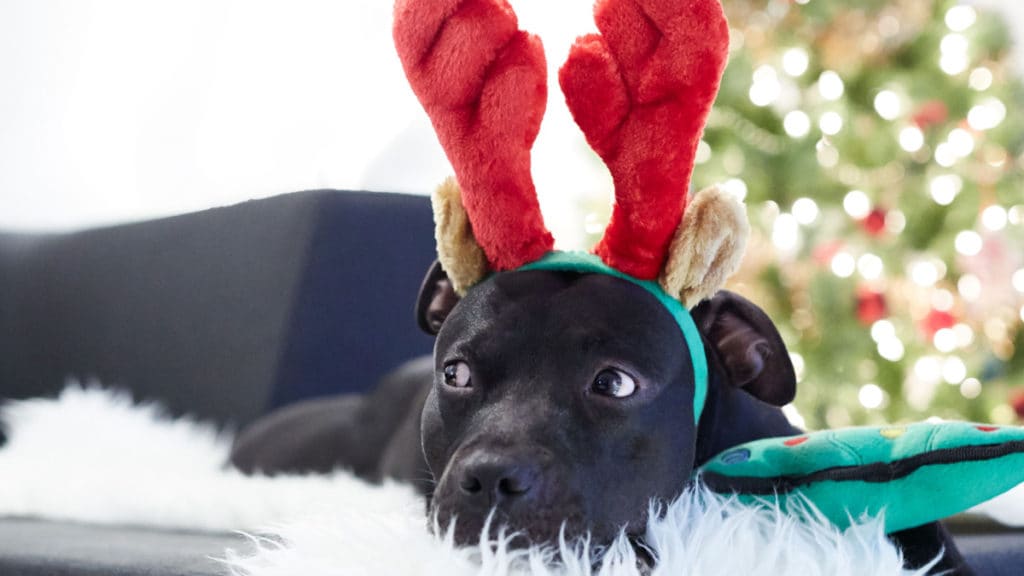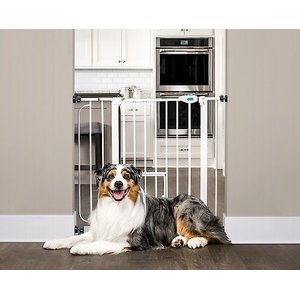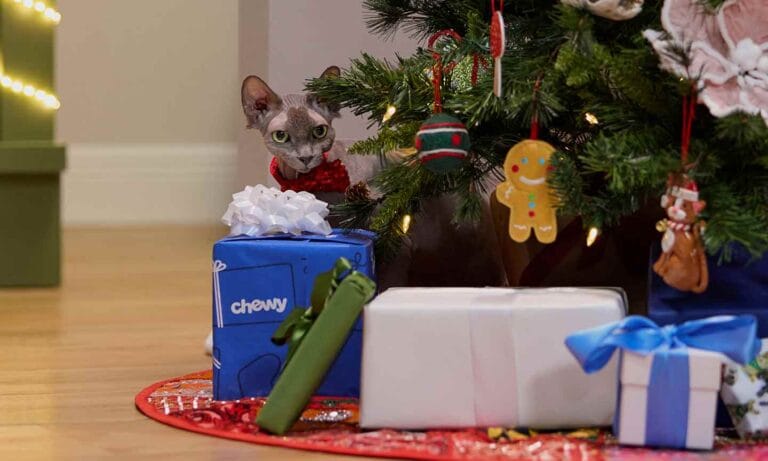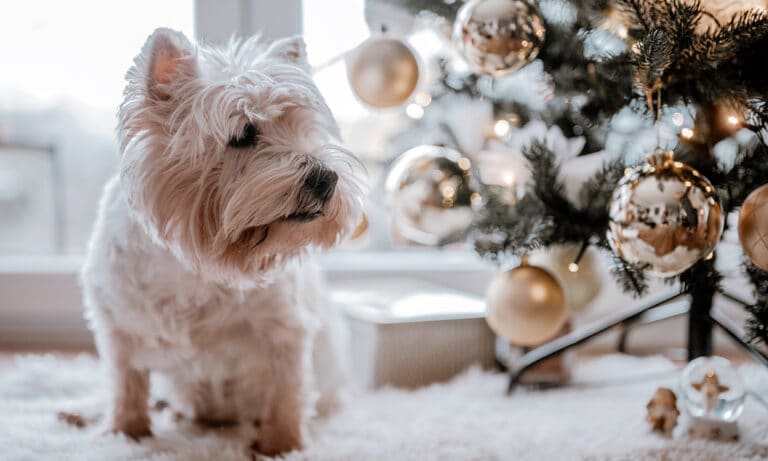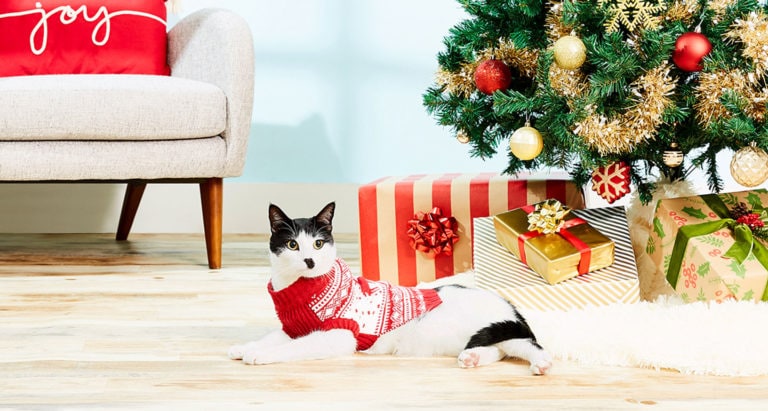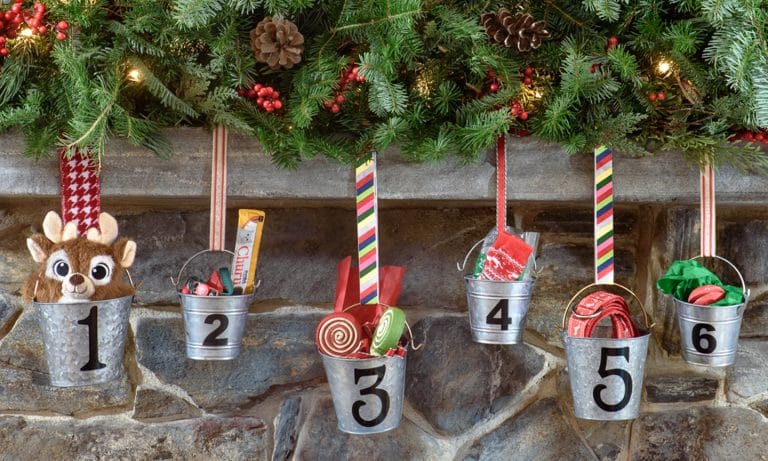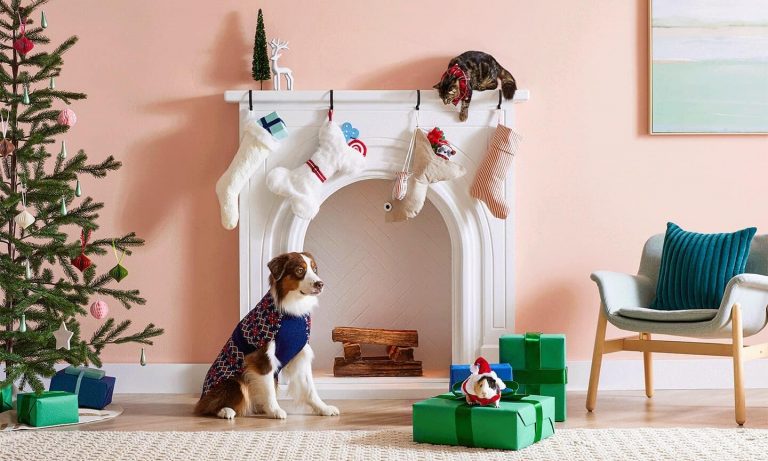The holiday season is meant to be merry and bright, but all those glittering lights, trimmed trees and tempting treats can make this time of the year dangerous for our four-legged friends. In order to keep everyone in a holly-jolly mood this month, here are some simple holiday safety tips to pet-proof your home because cats and Christmas trees are not as great of a combination as hot chocolate and marshmallows.
Decorations Can Be Dangerous: Appearances can be deceiving—that glittery tinsel on your tree is actually a serious threat. It is in a cats’ natures to want to play with anything string-like such as tinsel that you use to decorate your tree. They often swallow it, which can pose a threat to the intestines. This can lead to an emergency condition called a linear foreign body, where the intestine will bunch up around that tinsel and require emergency surgery to remove. In some cases, too much of the intestine can be damaged and it can be a life-threatening situation.
Veterinarians recommend skipping the tinsel altogether—and anything else including or acting like string. Unless you are hanging them out of the way where your furry friend cannot climb or jump to. Remember, cats love to climb and can jump high, especially if garland or lights attract them. Most holiday hazards may seem like common sense, however it is always best to consider the worst case scenario. As you are putting your decorations around, the best thing is to contemplate if and how your pet can get access and potentially endanger themselves. If your pet can access it and it can cause possible physical harm or toxicity to them, you probably want to keep that decoration in the storage box.
Holiday Houseplants to Avoid: Houseplant toxicities are more common in cats than in dogs since cats like to nibble and chew on leaves and flowers. However, keep in mind that puppies, especially when teething, will chew on plants also. Toxicity signs are typically dose dependent and if mild, only cause mild gastrointestinal signs such as vomiting and diarrhea. However, in moderate or severe cases, seizures, respiratory or cardiac depression, or sudden death can occur.
• Holly: is a popular yuletide decoration that can cause vomiting, diarrhea, inappetence, lethargy and head shaking.
• Lilies: and their many varieties like Tiger, Asian, Japanese Show, Stargazer and Casa Blanca are very toxic to cats; they can cause kidney failure with just one lick of a leaf, stem or flower.
• Poinsettias: can irritate the mouth and stomach, causing vomiting and skin irritation.
• Mistletoe: can cause vomiting, diarrhea, walking drunk, collapse or abnormal heart sounds; the berries are especially toxic.
• Amaryllis (Belladonna): can cause vomiting, diarrhea, drooling, a drop in blood pressure and respiratory depression.
• Hibiscus: can cause vomiting and diarrhea.
Avoid a Christmas Tree Cat-astrophy: Holiday trees are a staple of the season, but they are especially risky for cats. Remember that it’s standing on the floor, and your cat loves to climb trees instinctively. Consider anchoring your tree with 200-pound invisible fishing line hooked to the wall or ceiling. This should make them able to withstand the most intrepid explorers. And any ornament that can break and shatter should be secured soundly and placed toward the top of the tree—or skipped over, altogether—this will allow cats and Christmas trees to coexist. The Frisco Fold & Carry Double Door Dog Crate can keep your pets safely away from the tree when you are not home to supervise.
Some things a pet parent might overlook: Christmas tree pine needles and Christmas tree water. Not only are the needles sharp and can easily puncture your pet’s tongue, paw or intestines, but the tree stand water may cause vomiting, diarrhea or lethargy if ingested and may lead to emergency hospital visits. Be sure to keep a broom next to your tree so you can sweep up needles daily, and watch for cats and dogs that like to sleep under the tree, as they may wake up to take a mid-nap drink. In the event of an emergency, have some first aid staples on hand, like the Four Paws Quick Blood Stopper Powder and Nutri-Vet Assorted Color Bitter Pet Bandage.
411 on Holiday Food: Unfortunately, holidays can correspond with an increase in food-related poisoning for pets. All those tempting treats spell major danger for our animals. It’s natural to want to share the goods with our four-legged pals, but among the best holiday safety tips is not giving in to those big puppy eyes pleading for scraps.
Another big culprit is chocolate, which contains caffeine, theobromine, and methylxanthines—a substance found in cacao seeds. Baker’s chocolate, especially, has the highest level of methylxanthines. So something as simple as setting out the brownie mix becomes increasingly risky if you have a dog underfoot. Dog gates like the Carlson Pet Products Extra Wide Walk-Thru Gate with Pet Door keep your pup out of the kitchen. And if Fido has already gone and gotten into that box of assorted truffles, it’s a good idea to have the nearest emergency veterinary hospital or Pet Poison Hotline’s number stored in your phone to call for help.
Other items you’ll find on the holiday table and may not immediately consider a threat include grapes, raisins, onions and garlic (or foods which include onion or garlic powder), usually found in sweets like panettone and fruitcake and foods such as stuffing and mashed potatoes. These fruits and vegetables can lead to severe stomach upset and kidney failure. And while it might seem picturesque to put down a saucer of milk for kitty on Christmas Eve, it’s best to avoid it. Though milk-based products are not necessarily toxic, they can cause diarrhea in cats and dogs, as pets can be lactose intolerant just like humans.
Don’t Buy Precarious Presents: Most pet parents want to get their furry pal in on the fun for the holidays. We hang stockings embroidered with their name and leave boxes wrapped in paw-print paper under the tree. Some rules-of-thumb when shopping:
• Skip small toys. When planning a holiday purchase for your pet, make sure that you do not buy any toys that contain pieces such as bells, strings or googly eyes that are small enough for them to swallow, as they can lead to foreign bodies as previously discussed.
• Throw ‘em a bone—but only if you’re watching. Keep an eye out for anything large that gets progressively smaller, like a rawhide bone or dental chew. Even though some brands of dental chews are recommended by your pet’s veterinarian, it does not mean they are always safe. Every dog is different, and even though the chew is meant for chewing, it does not mean that your dog will only chew and not bite off large pieces once it is soft enough to do so. Anything small enough for them to swallow can become a big problem once it gets caught in their throat or stomach.
• Opt for soft treats. Treats that are harder than your pets teeth are not recommended, as heavy chewers may break or fracture their own teeth.
In conclusion, remember that the holidays were created by people. While your pet will be psyched about receiving any out-of-the-ordinary treatment, they aren’t expecting it. If it is not part of their normal diet or has caused stomach issues in the past, it’s not a good idea now just because it’s a special feast for you. These holiday safety tips will keep your pet safe and your holidays jolly by separating cats and Christmas trees and dogs and cookies.
Share:
